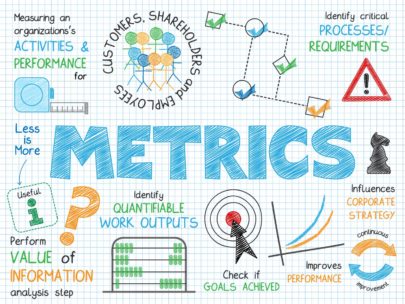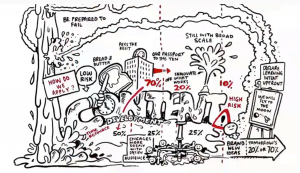 As Agile marketers, we value validated learning over opinions and conventions. Learning is validated by gathering the right metrics to confirm that our marketing is working or not working. But what are the right metrics?
As Agile marketers, we value validated learning over opinions and conventions. Learning is validated by gathering the right metrics to confirm that our marketing is working or not working. But what are the right metrics?
Like many things in life, the answer is “it depends”.
The right metric varies depending on the type of business (Enterprise B2B, B2C, SAAS B2C2B, Non-profit, etc) and on the maturity of the company. Over the next few weeks, I’m going to write about some of the different types of business listed above, and try to distill, for each business and each stage, the most relevant metrics.
Enterprise Business to Business (B2B)
I’ve spent most of my career in Enterprise B2B, so it’s natural for me to start there. Below are three stages that most Enterprise B2B companies go through, and the high level metrics associated with success at each of these stages.
Stage 1 – Creating monetizable value
When I work with startups, particularly those that are started by technical founders, they often build a product and then hire one or two “sales people” to sell the early customers, imagining that each salesperson will bring in $500K to $1M a year in revenue, and the company will take off. Most of the time, this doesn’t work. The startup burns through lots of cash, and has only a few customers to show for it, many of whom are “trials” with limited or no revenue.
I advise founders to take a different approach. Up front, before they’ve built the product, I encourage them to talk to prospective customers and explain exactly how their product or service is going to create value for the prospect. The prospective customer needs to share the vision of the future value, and they have to believe enough to pay for the value they are going to realize. At this point, founders are not salespeople, but value creators and negotiators, two critical skills for any founder.
By the way, I’m using the terms startup and founder, but this can apply to any new product or service, even if it comes from a very large and established company. When I worked for Microsoft, I remember going through this stage for SQL Server, because with version 7, we completely re-wrote and re-launched the product.
The right metric for this stage is the number of happy customers who will serve as references to your future prospective customers. The amount of revenue from these customers is also significant, but the goal is to create references and the knowledge of how to create monetizable value.
Stage 2 – Scale to viability
Once you’ve created 3-10 happy, highly referenceable customers, the next stage is to scale to viability. This is also known as break-even (or better). Now is the right time to hire a sales staff and a marketing team, whose task is not just to create the next 3-10 customers, but to create at least one order of magnitude more customers. In other words, they need to create the repeatable processes necessary to create the next 30-100 customers.
The marketing department can’t control all of the costs associated with viability, so it is inappropriate to hold them to this standard. However, they can and should be focused on two metrics:
- Total contract value of sales qualified leads
- Average time to revenue
Let me take each of these in turn. I’m assuming that most of my audience is familiar with the term sales qualified leads, or SQLs. In brief, these are leads that meet agreed upon thresholds, negotiated between sales and marketing, to warrant sales follow up. The number of leads is important, but even more important is the amount of revenue that they represent. Every salesman would rather have a smaller number of high potential leads than a large number of small potential leads. Each lead should have a forecast of total contract value associated with it, and the sum of these TCV numbers represents the value that marketing is contributing to growing the pipeline.
The second metric is average time to revenue. Some marketing people would say that once they’ve delivered the SQL, it’s then out of their hands, and sales should be held accountable for the time to close the lead. I disagree. Marketing is responsible the entire customer experience, and marketing needs to work with sales, in support of closing that lead. The messages that the lead hears before speaking to a salesperson need to be consistent with the messages from the salesperson, and the salesperson needs to be equipped by marketing with all the tools they need to close the sale.
Stage 3 – Creating Profitable growth
Stage 3 requires another leap, generally by another order of magnitude. If the goal in stage 2, for example, was 50 customers, the goal for stage 3 would be something like 500 customers or more.
This requires that the systems for acquiring customers be even more efficient and more predictable. Often, this requires multiple channels. In addition to their direct sales force, enterprise B2B companies will also develop channels at this point (and not earlier), where third-parties can sell the product or service with limited direct involvement from the company.
The metrics from the earlier stages, particularly the total contract value of leads and the average time to revenue, remain relevant, particularly for the direct sales force. However, two more metrics generally also become relevant:
- % of revenue coming from third-parties (channels)
- Cost of acquisition
The first metric should be obvious. At this stage, you’re trying to increase your reach, and the frequency of sales, and you can’t do this through a direct sales force alone.
The second metric, cost of acquisition, is often poorly understood in Enterprise B2B companies. If the goal of the entire company at this point is profitability (probably measured by EBITDA), the most important part of the profitability equation that can be controlled or at least influenced by marketing, is the cost of acquisition. How much does it really cost to acquire a customer? Is this lower or higher through certain channels? What are the most efficient ways to acquire a new customer? These are key questions for marketing to answer in stage 3.
What do you think? What metrics do you use to measure marketing in an Enterprise B2B company?



